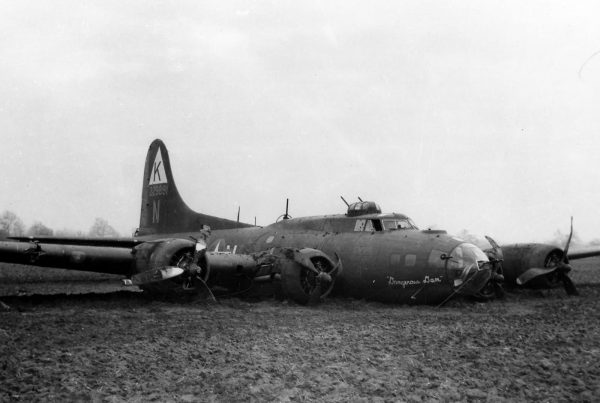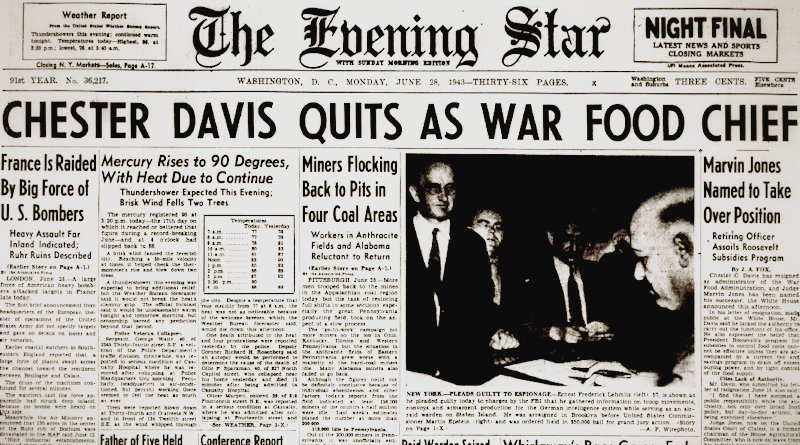World War II Chronicle: June 28, 1943
Click here for TODAY’S NEWSPAPER
On the second page, 2nd Lt. Murray J. Shubin has become an “ace in a day.” The P-38 Lightning pilot was part of a four-ship formation that caught 15 Zeros by surprise. One by one, his squadron mates had to peel off due to damage or jammed guns, leaving him to face the last five enemy fighters alone. Shubin knew he destroyed two, but due to the frantic action was unable to account for whether or not his damaged opponents were in fact shot down.
The action took place over Guadalcanal on June 16, and an intelligence officer watched the air battle through binoculars confirmed that Shubin shot down five. Ground troops saw another Japanese plane go down in flames, making a sixth kill possible. Shubin is awarded the Distinguished Service Cross for his aerial feat. He had shot down two enemy aircraft already, and will add four more before the double ace rotates back home to serve as an instructor… His unit, the 339th Fighter Squadron, is credited with shooting down Admiral Isoroku Yamamoto earlier this year…
An Eighth Air Force B-17 gunner landed his bomber when the pilot and co-pilot were seriously wounded during a raid. Sgt. Clifford T. Erickson is pictured on top of page nine. There may be other B-17s named Dangerous Dan, but Erickson serves in the 379th Bomb Group and another Dan will crash-land in December 1943 and is written off.

George Fielding Eliot column on page 10… Sports begins on page 16.
Roving Reporter by Ernie Pyle
SOMEWHERE IN AFRICA — From Cairo we retraced the whole long trail over which General Montgomery chased Rommel last fall and winter, all the way from Egypt to Tunisia. Lord, what a vast blank distance it is!
The desert in western Egypt and eastern Libya is absolutely flat, absolutely barren. It is like looking down on an endless skating rink.
From the air we could see where the war had been. We could see the wrecked and blackened tanks by the score. We could see dumps of abandoned gasoline cans and used boxes, wrecked ships on the beach, crashed planes, and even gun pits that had once poured out steel and death. Everything stood out as though it had been painted, for there was nothing else at all on the desert except these remnants of war.
But the one thing that fascinated me most was the tracks of the tanks and the trucks. Yes, they were still there. The winter’s winds had not covered them up. There were absolutely billions of tracks in the sand, tracks swerving and turning and intertwining as far as you could see. Never was such a plain picture drawn of modern war’s mobility as that grandstand view of the infinite tracks in the sands of Rommel’s defeat.
We stopped over for a day at Tripoli, and I was disappointed Il Duce’s paradise city. Oh, it was all right, but now take some comparable place like Santa Barbara and you’ve … oh well, let’s skip it.
I rode a truck into town with a bunch of pilots in the afternoon. Some of the boys were looking for bright lights, and they disappeared. Others went to get their hair cut. Two more and myself went down to the harbor and stood there for a while looking over a wire fence at all the wreckage.
There were few Italians in the streets, but most of the street population seemed to be British and American soldiers. This was shortly after Tripoli fell, remember.
It didn’t seem to me that what few Italians we saw were having any trouble restraining their joy. We were surprised to see Italian officers in the streets.
The fronts of the downtown buildings were pretty well smacked up by flying bomb fragments, but on the whole the city wasn’t devastated like Sfax, Gabes and Bizerte. It was mainly the harbor that got it.
Most of the shops were closed but a few were open. There were signs at the airport warning us against drinking any of the local liquor, as it is known to produce ailments ranging from blindness to insanity. But we don’t see any evidence of any liquor to drink anyhow.
In boredom we finally wound up in a little teashop, drinking lukewarm coffee and eating soggy little French pastries. The place was packed with English army men. It seemed incongruous that an Italian shopkeeper in a town that had just been conquered should be running around his crowded shop taking in money hand over fist from his conquerors.
Our truck wasn’t due to start back to camp till 4 o’clock, and by 3:30 we had seen all of Tripoli we wanted, so we bought a nickel’s worth of peanuts apiece) for which we paid the equivalent of 20 cents) and sat on the floor truck eating them till time to go.
The next morning we left Tripoli on the last day of our long flight home.
Looking back over Africa, there are a few little brag-mag items I didn’t get around to and haven’t got room to do more than mention here — just a scattering of notes like passing thoughts … I was in one city where second-hand Packards sell today for $20,000 in American money, and where people pay a thousand dollars for tires … Pilots on our ferry routes over here are flying as high as 150 hours a month, the maximum on the airlines back home being 90 … In one city, where gasoline is almost extinct, you see dozens of autos with horses hitched to them, being used as taxis … All through Central Africa the first thing a man does when you are introduced is to whip out his Short-Snorter bill and have you sign it.
Many people are making collections of paper money from different countries, pasting the ends of the bills together with Scotch tape. I saw many rolls so big you couldn’t get them in your pocket, and I saw one more than 35 feet long. In these travels I saw the largest Negro city in the world outside of Harlem (I’m sure you’ve never heard of it), and I saw anthills higher than a two-story house … In one country the earth is a sort of pinkish-red, and when the wind blows this pink dust settles in a thin coat over everything. Pilots have been startled to look down and see herds of honest-to-goodness pink elephants … That’s enough for today.
Evening star. (Washington, D.C.), 28 June 1943. Chronicling America: Historic American Newspapers. Lib. of Congress.
https://chroniclingamerica.loc.gov/lccn/sn83045462/1943-06-28/ed-1/
